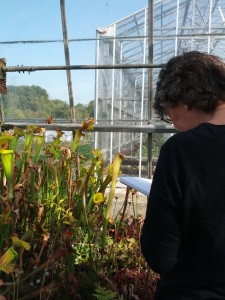After a long and exciting summer of sci-art, I’ve been pleased to get back to the Herbarium as a visiting artist, and round off the season with a visit from another lichen-loving artist, Louisa Crispin. I’m also starting work on a commission that brings together electron microscopy and plant sciences research; but more about that and EM Lab’s SEM imaging next time.
Louisa Crispin is a fellow artist, who shares my love of drawing and lichen, and her intensely detailed and skilled pencil work is fascinating, as you can see from the drawing above! Louisa visited Herbarium RNG and the living collections earlier this month. Below you can see Louisa sketching Sarracenia from the inspiring display in the glasshouses, and one of her sketches. Follow her amazing drawings on twitter at @Louisa_Crispin
Louisa’s visit is a great example of the tangible benefits of online networking. Networking allows us to share experiences, resources and information; this spirit of collaboration is important for all our disciplines – art, science, and sciart! Its also particularly beneficial as an artist, given that arts practice can be quite solitary, so online networks enable us to break from long hours in the studio and share our thoughts with others. Science PhD students can benefit from similar support, I know I did (my PhD is in Pharmacology.) So don’t be shy, get online!
From the rest of summer, I’ll share some links to interesting art & science happenings as a kind of botanical #FF;
- I had the pleasure of touring Flor & Fjære Gardens in Norway; surely one of the most Northerly outposts of tropical gardening. I was mainly looking at lichen while I was in Norway, but in particular the apple tree hedgerows at Flor & Fjære were impressive.
- I visited the Economic Botany Collection at Kew, researching native British medicinal plant histories. Mark Nesbitt gave Alastair Culham and I a tour of the herbarium archives. The labels on old bottles are particularly fascinating!
- I visited the ‘Future Human’ events by Broad Vision at GV Art. One of the great things about art is that it is not limited by reality, and can ask ‘What If’ questions to which there may be no scientific answer. We had great fun asking ‘what if plants existed in a world without sunlight?’ and imagining if plants could survive using bioluminescence.
- Did you know the Hunterian Museum at the Royal College of Surgeons includes botanical specimens? I didn’t until I visited this summer with Sally Hunter, for Imagining Science. Get down there for some interdisciplinary interest, botanists!




